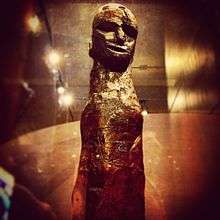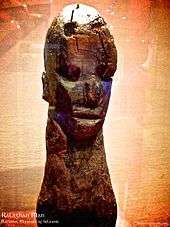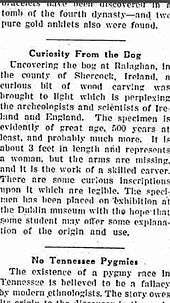Ralaghan Man
Ralaghan Man is an anthropomorphic, carved wooden figure found in the bog of Ralaghan, County Cavan, Ireland, which dates back to the late bronze age. As of 2016, it was held in the collections of the National Museum of Ireland.[1]

Discovery


Adolf Mahr, keeper of Irish Antiquities in the National Museum in Dublin wrote in 1930; "The figure was found, while cutting turf, under 3 to 4 feet of peat....It is made of yew, its height being 3 feet, 8 and five eighths inches".[2] It was found in Ralaghan bog, which has since been drained, on a boundary. It is therefore currently regarded as a boundary marker, though it has also been referred to as a votive offering.[3]
Description
Although covered in cracks, the figure has strongly incised facial features.[4] The left eye is slightly higher than the right, with the nose off-centre and possible damage to the left of the face. The pubic area features a gouged out hole (initially reported as drilled)[2] with some theorising that the figure was female (drawing associations with other figurative female representations, such as stone sheela na gig carvings).[5] Some other theories identify the figure as male, suggesting that the hole may have been used to hold a 'carved phallus' (since lost).[6][7]
Display
As of 2016, Ralaghan man was displayed as part of the Kingship and Sacrifice exhibition at the National Museum of Ireland.[1]
See also
- Dagenham idol - similar wooden figure found close to London in 1922
References
- "Kingship and Sacrifice - New Theory of Sacrifice". museum.ie. National Museum of Ireland. Archived from the original on 26 January 2016.
- Mahr, Adolf (1930). "A wooden idol from Ireland". Antiquity. 4: 487.
- O'Sullivan, Aidan. "Exploring past people's interactions with wetland environments in Ireland". Academia.edu. ria.metapress.com. Retrieved 28 July 2015.
- Coles, Bryony (1990). "Anthropomorphic Wooden Figures from Britain and Ireland". Proceedings of the Prehistoric Society. 56 (2050–2729): 315–333. doi:10.1017/S0079497X0000517X.
- Freitag, Barbara (2007). Sheela-na-gigs: Unravelling an Enigma. Sutton. p. 107. ISBN 9780750945981.
Mainly because there is not the slightest indication of breasts on any of them, some archaeologists are inclined to believe that the Ralaghan and Dagenham figures represent males, and that the hole was meant for the insertion of a now missing penis. Since the absence of breasts in female idols is familiar, such an interpretation does not naturally follow. Indeed, the stones inside the pubic hole of the Ralaghan idol and the oval shape of the hole in the Dagenham figure, strongly indicative of female representation - and ill-designed, according to Coles, to hold a penis - would tell us otherwise
- Williams, Mark (2016). Ireland's Immortals: A History of the Gods of Irish Myth. Princeton University Press. p. 6. ISBN 9780691157313.
One [pomorphic wooden image] found in the bog of Ralaghan, Co. Cavan is roughly a metre long and made from a single round trunk of yew: it has a gouged hole in the genital area, which may once have held a carved phallus
- "Ralaghan Man". agsmaoineamh.com. Archived from the original on 12 September 2014.